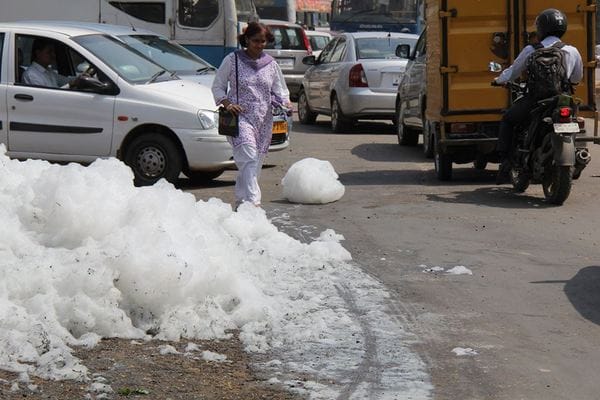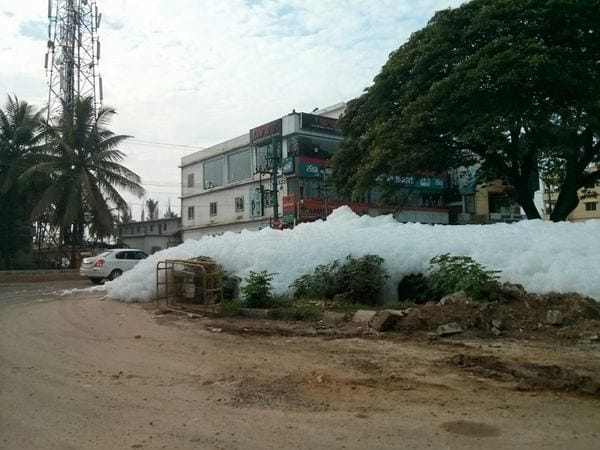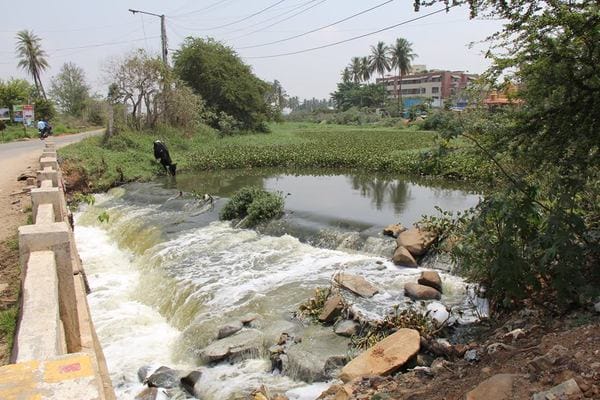
Lather flowing onto the road near Varthur lake. Pic: Murali Govindraju
On Wednesday April 29th, Bengaluru made national headlines once again. The reason: rising pollution in Bengaluru’s lakes, a proof for which was the snow-white effervescence seen in Varthur lake. Despite it being a weekday, many young kids, working professionals and old residents of Whitefield-Varthur area turned up near Varthur lake where large volumes of white lather had risen from the lake.
After the rains in Bengaluru over the last couple of days, many lakes have started carrying huge volumes of snowy froth. This froth which would have otherwise been a sight to behold, stinks, and on contact with skin, causes irritation.
The lather is a common sight in Varthur and Bellandur lakes, when large volume of rainwater mixed with sewage, enters the lakes. The mass of lather in the Varthur lake rises so high that it lands on the road nearby, irritating passersby, especially those travelling on two-wheelers.
This is a concern with many lakes in Bengaluru during the rains, and is common with those that are connected to storm water drains directly, especially in areas where BWSSB has not installed the underground sewage network.
Priya Ramasubban from Mahadevapura Parisara Abhivruddhi Samithi which manages the Kaikondrahalli lake near Sarjapur Road, says that Kaikondrahalli lake too witnesses such lather when sewage enters the lake along with rainwater.
How does the lather form?
According to a study conducted by the Department of Environmental Science, Bangalore University in the year 2008, for the Ministry of Environment and Forests, the banks of Varthur lake reveal the presence of nitrates above the permissible level.
The research also states that these nitrates can be toxic to human babies. Bacteria present in the digestive tract convert nitrate into nitrite. Nitrite reacts with hemoglobin to form methemoglobin, a form that does not carry oxygen. The baby essentially suffocates as its body does not receive sufficient oxygen (also called Blue Baby Syndrome).
T V Ramachandra, a scientist at Indian Institute of Science (IISc), and his team have conducted many studies on the phenomenon. Ramachandra says that the lake water is 99% polluted. IISc collected a sample of the lake water for testing, and found that it had traces of nitrates, potassium, sulfates and many other components. The nitrates come from urine and fecal matter, and soaps and detergents are the source of sulphates and phosphates. This only goes to prove that large volumes of untreated sewage water enter the lake.
When the mixture of nitrates, sulfate and sewage is mixed in the rainwater and flows onto a lower level or through stones, it lathers up. During heavy rains, when the flow of water to the lake increases, the quantity of lather increases and it overflows. Ramachandra adds that the lather is soapy in nature and smells like detergent.

Mass of lather from Varthur lake spilling on to the road. Pic: Biju Nair
What is the lather made of?
Ramachandra says that the lather generated in Varthur Lake is caused by detergents present in the sewage (from domestic waste). These detergents contain polyphosphates, and make their way to lakes, when the domestic sewage lines are connected to storm water lines.
Rajashekar, Environmental Officer of KSPCB, Bangalore East confirms the same: “The detergents used in households for washing purposes enter the stream of sewage water. In areas with no proper BWSSB pipelines, the sewage line is simply connected to the storm water drain which flow directly to the lakes. It is this detergent content in the lake that creates the lather on the lake’s surface.”
He adds that this is particularly acute during summer, as heat triggers a quicker reaction, and because the quantity of water in the lake is relatively less, the concentration of detergent content in the water is higher. When it rains, this detergent content mixes with the excess of rainwater to create lather. The area between Bellandur and Varthur lakes, Yemalur and other areas situated near the channel that connect Bellandur lake to Varthur lake, have been suffering the most.
Is the lather harmful?
Ramachandra however maintains that the lather is not harmful or dangerous, and that people need not worry if they come in contact with it, unless they are allergic to detergents.
Residents in Yemalur area however feel differently. Abhinandan, a resident of the area says, “The lather keeps flying around through the day. A drop of this lather on the skin causes irritation. The foul smell too is intolerable.”
The lather could also be hazardous to motorists. While no accidents have been reported so far, there is a possibility that it could temporarily blind someone if it enters the eyes; two-wheeler riders are susceptible to this. Or if it were to land on the windshield of a four-wheeler, it could block the vision until it is cleaned.

Cattle drinking water from Varthur lake. Pic: Murali Govindaraju
‘Treating water the only long term solution’
Mr Khan, the Principal of K K School in Varthur says, “The sewage lines must be disconnected from the storm water drains and the water from the storm water drains must be treated before it is let into the lake.”
IISc scientists say that unless the other upstream lakes in Koramangala-Challaghatta valley which flow into Varthur lake, are treated, there is nothing that can be done to restore Varthur lake. Bengaluru’s lakes are interconnected, and domestic sewage let into a storm water drain in Madivala or HSR Layout can cause foaming in Varthur.
When asked, Vishwanath, rainwater expert, said that wetlands should be created near every lake and the treated sewage should be let into the wetland before it is let into the lakes directly. The BWSSB should increase the capacity and standard of treating sewage, he added.
BWSSB working towards treating water
The BWSSB has begun the construction of a Sewage Treatment Plant near Varthur lake 10 months ago. Chief Engineer of BWSSB, Krishnappa estimates that it will be completed in another 26 months.
“The water will be given a secondary treatment (in which settleable solid particles are filtered by a physical process, and the water is then freed from dissolved and suspended organic compounds using a biological process) before it is allowed to flow into the lake. By thus preventing flow of detergents into the lake, lather formation on the lake can be prevented,” he said.
However, setting up STPs will not settle the problem in itself, BWSSB Chief Engineer Ramakrishna said. “Underground drain pipes must be laid in the 110 villages surrounding Bangalore. Without it, the sewage will not reach the STP, but will continue flowing into lakes without being subjected to treatment.” The work is estimated to cost Rs 5000 crores and BWSSB is still waiting for the amount to be sanctioned by the government.
An Executive Engineer from the BDA, Rizwan Baig explained that the complicated process of rejuvenating the 950 acre Bellandur lake can only be started when the BWSSB ceases to dump sewage. The BDA can fence the area after the dumping stops and the Revenue Department marks the boundaries of the lake, concluded Baig.
BWSSB Assistant Executive Engineer, Srinivas, who is in charge of sewage and sanitation in the Yemalur area, said, “There is already a UGD (Underground Drainage) project going on and the target for the network to be complete is December 2015. After that, sewage will not flow into the lake.”
The project to lay underground sewerage system for K R Puram and Mahadevpura area was taken up under JNNURM scheme, and was sanctioned by the Central government in February 2014. With the new NDA government that came into existence in May 2014 scrapping JNNURM scheme, and with the outlines of the Smart City scheme that will replace JNNURM scheme yet to be in place, the project meant for Mahadevpura is facing uncertainty, according to a Deccan Herald report. Out of Rs 305 crores, Rs 106.7 crores were to be given by the Central government for the UGD in Mahadevpura area, in the first phase.
Groundwater pollution a major cause of concern
While lather caused during rains is the most visible indication of pollution, it is the least of the problems caused by polluted water. The most important problem is the polluting of groundwater. In an independent test conducted by IISc in 2013, it was found that borewell water in Varthur village area around the lake was high in nitrates, which can cause cancer—in other words, carcinogenic.
High nitrate levels in water can cause methemoglobinemia or blue baby syndrome. Methemoglobinemia can result in brain damage and death. Nitrate is readily absorbed and excreted in the urine. However, prolonged intake of high levels of nitrate has been linked to gastric problems.
Most of the tankers around Bellandur and Varthur area get their water from the borewells dug around Bellandur and Varthur lakes, which is supplied to the apartments in the area. Hence, the groundwater contamination in the area requires urgent attention, said K Elangovan, an environmentalist, in a debate on Headlines Today, an English news channel.
Bengaluru’s problem is that 70% of the sewage water is not treated: K Elangovan, Environmentalist #NTA9 http://t.co/SHMPbYCrGr
— India Today (@IndiaToday) April 29, 2015
200 mails that received no reply
Abhinandan, a resident of Yemalur, an area between Bellandur and Varthur lakes, has been mailing the BBMP commissioner, Lokayuktha, PC Mohan-MP, Bangalore Central, Lake Development Authority, KSPCB and other authorities for the last 200 days. One such mail reads: “Got up from dirty smell formed in lake near Yemalur bridge. For last one year I have been complaining about lake condition but now the smell from lake has become unbearable. The smell is 24/7. Please take immediate action to ensure the lake water is flowing properly.”
In his mails he lists out the reasons for the stench, such as dumping of garbage in the lake and other reasons, and highlights the health concerns of the people living in the area. Abhinandan is yet to hear back from any of the authorities. However, Abhinandan hasn’t stopped writing.
The froth attracts the children from the nearby construction sites, despite the immediate irritation it causes on contact with skin. To determine the exact composition of the lather, the secretary of the Residents’ Association of Vista Lagos, Vishrut Singh is attempting to get a sample tested.
Families with young children have moved out of the area to distance themselves from the huge health hazard posed by the froth that is often carried by the wind, sometimes even upto the second floor of homes and apartments nearby.
Vinu Varghese, a resident of Vista Lagos Apartment, moved to another part of the city for a few months after his child was born.He says that he still has to take precautions to protect his family’s health, “We don’t open the windows or leave the door open, so the number of mosquitoes is not too bad. We don’t leave our apartment to go to the common area, because there are so many there.”
With the stagnant water of the lake, the mosquito population thrives. The human population on the other hand suffers with the stench. While the citizens of Whitefield are working towards restoring the lakes, it remains to be seen how long the process will take, as the process is complicated and requires large amount of money.
With inputs from Pavan Kulkarni and Pavithra Ashok Kumar.
Related Articles
Saving a dying lake just got easier, with court mandate
How to revive your neighbourhood lake
This is not new although not good. I remember during the school days we used to go cycling to this place since it was very quiet those days and there was no development whatsoever at that time and the lather would fly around the entire area when it rained even at that time which must be 15 years back.
Why not have an additional inlet to the Treatment plant that gets water from the lake. That will keep taking in dirty water. This will slowly treat the quality of water. Drainage for villages will take a few years.
Who cares about who lives in what condition here?!.
The elected representatives are happy they got the votes and won & are comfortably sitting in their A/c cabins getting their ‘share’ periodically.
Only one question to them: if this happens near your house, will you sit quite like this?
We citizens are also one way main cause for such situations. If we care ourselves for the ‘clean India’ project, and can contribute our share in keeping things and places properly, we need not have to go and beg these ‘big wigs’ !
Really fail to understand how to ‘change my city’ at this rate even i want it when I am surrounded by all these unconcerned authorities.
Now I understand the reasons why our youngsters prefer to run away leaving their aged parents also and settle abroad.